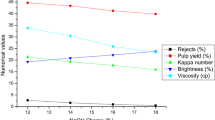Abstract
In this paper, physical, morphological and chemical characterizations of the six main mangrove species of Bangladesh [namely Keora (Sonneratia apetala), Gewa (Excoecaria agallocha), Bine (Avicennia alba), Sundari (Heritiera fomes) Pashur (Xylocarpous mekongests) and Kakra (Bruguiera gymnorhiza)] were discussed in order to assess the suitability of pulping raw materials. The wood density of these six mangrove was found to be 0.5–0.6 g cm−3 except Gewa which had 0.39 g cm−3. The fiber length of these species was varied from 0.74 to 1.2 mm that was considered as short fiber. Sundari contributed the longest fibre length (1.2 mm) among these six species. The chemical results revealed that these species contain high percentages of dichloromethane, followed by methanol extractives. Methanol extracts in Pashur, Sundari and Bine was higher than 10 %, which indicates high percentage of tannin material. These species were characterized with high lignin content and low α-cellulose content. The pulping of these six mangrove species was also carried out by kraft process and papermaking properties were also evaluated. Pulp yield was lower and kappa number was higher as compared with other tropical hardwoods. But the physical properties of these species were quite acceptable. Considering pulp yield, kappa number and physical properties, it may be concluded that Keora and Gewa can be used as kraft liner and other packaging grade paper pulp.




Similar content being viewed by others
References
Anon (2001) The Bangladesh tropical conservation fund: preventing and arresting accelerating species loss in Bangladesh. Chemonics International Inc., Washington, DC
Anon (2003a) Population census 2001. National report (Provisional). Bangladesh Bureau of Statistics, Planning Division, Ministry of Planning, Dhaka
Anon (2003b) State of world forests 2003. Source: www.fao.org
Casey J (1980) Pulp and paper: chemistry and chemical technology, vol 1, 2nd edn. Interscience Publ, New York
Chakrabarti K (1987) Sundarbans mangroves-biomass productivity and resource utilization—an indepth study. Indian For 113(9):622–628
Fang SZ, Yang WZ (2003) Interclonal and within-tree variation in wood properties of poplar clones. J For Res 14(4):263–268
FAOSTAT (2013) Food and Agriculture Organization of the United Nations Rome, Italy. http://faostat3.fao.org/download/F/FO/E
Gellerstedt G, Gustafsson K, Lindfors EL (1986) Structural changes in lignin during oxygen bleaching. Nord Pulp Pap Res J 1:14–17
Goyal GC, Fisher JJ, Krohn MJ, Packwood RE, Olson JR (1999) Variability in pulping and fiber characteristics of hybrid poplar trees due to their genetic makeup, environmental factors, and tree age. Tappi J 82:141–147
Hale JD (1959) Physical and anatomical characteristics of hardwoods. Tappi J 42:670–677
Jackson F (1988) Fiber length measurement and its application to paper machine operation. Appita J 41:212–216
Jahan MS, Mun SP (2003) Characterization of Nalita Wood (Trema orientalis) as a source of fiber for papermaking (Part I): anatomical, morphological and chemical properties. Korea Tappi J 35(5):72–79
Jahan MS, Mun SP (2004) Effect of tree age on the Soda-Anthraquinone pulping of Nalita Wood (Trema orientalisis). J Ind Eng Chem 10(5):766–771
Jahan MS, Sabina R, Rubaiyat A (2008) Alkaline pulping and bleaching of Acacia auriculiformis grown in Bangladesh. Turk J Agric For 32(4):339
Jahan MS, Maruf MM, Chowdhury NDA (2009) Pulping of Keora (Sonnertia appetula) a major mangrove species of Bangladesh. Ippta J 21(2):51–54
Kai K, Goto T, Ishida M (1974) Studies on dissolving pulp from mangrove. (1) cooking behaviour. Jpn Tappi 30(2):26–30
Kai K, Goto T, Kojima K, Ishida M, Morigami S (1975) Studies on preparation of dissolving pulp from mangrove wood. 7. Qualification of various kinds of mangrove woods for dissolving pulp. Jpn Tappi 29(12):650–656
Khristova P, Gabbir S, Bentcheva S, Dafaala S (1997) Soda-AQ pulping of three Sudanese hardwoods. Trop Sci 37:176–182
Kitahori T, Takenaka M (1972) Experience in using mangrove [species] for making coated paper and woodfree printing paper. Jpn Tappi J 26(6):263–267
Koeppen A, von Cohen WE (1955) Pulping studies of five species of a mangrove association. Aust J Appl Sci 6(1):105–116
Latif MA (1965) Viscose grade rayon pulp from Sundri (Heritiera minor, Lam.). Tappi 48(12):716–720
Miles DH, Kokpol U, Chittawong V, Tip-Pyang S, Tunsuwan K, Nguyen C (1998) Mangrove forests—the importance of conservation as a bioresource for ecosystem diversity and utilization as a source of chemical constituents with potential medicinal and agricultural value. Pure Appl Chem 70:2113–2120
Mun SP, Jahan MS, Al-Maruf A, Chowdhury DN (2011) Chemical characterization of six mangrove species in Bangladesh. Wood Sci Technol 45(2):281–288
Neto CP, Silvestre AJD, Evtuguin D, Freire CSR, Pinto PCR, Santiago AS, Fardim P, Holmbom B (2004) Bulk and surface composition of ECF bleached hardwood kraft pulps. Nord Pulp Pap Res J 19:513–520
Neto CP, Evtuguin DV, Pinto P, Silvestre A, Freire C (2005) Chemistry of plantation eucalypt: specificities and influence on wood and fibre processing. 13th international symposium on wood, fibre pulping chemistry; proceedings book, Vol. 2. Auckland, New Zealand, pp 431–438
Peng L, Yiming L, Jianhui L (2000) The secondary xylem anatomy of the mangroves Aegiceras corniculatum and Sonneratia caseolaris. Scientia Silvae Sinicae 36(2):125–128
Pietarinen S, Willfor S, Holmbom B (2004) Wood resin in Acacia mangium and Acacia crassicarpa wood and knots. Appita J 57:146–150
Pietarinen SP, Willfor SM, Sjoholm RE, Holmbom B (2005) Bioactive phenolic substances in important tree species. Part 3. Knots and stemwood of Acacia crassicarpa and Acacia mangium. Holzforschung 59:94–101
Santos AJA, Anjos OMS, Simoes RMS (2006) Papermaking potential of Acacia dealbata and Acacia melanoxylon. Appita J 58:58–64
Siddiqi NA (2001) Mangrove forestry in Bangladesh. Institute of Forestry and Environmental Sciences. University of Chittagong, Chittagong, BD
Sjöstrom E (1993) Wood chemistry. Fundamentals and applications, 2nd edn. Academic Press, San Diego
Watson AJ, Dedswell HE (1961) Influence of fibber morphology on paper properties. Part I fibre length. Appita J 14:168–178
Author information
Authors and Affiliations
Corresponding author
Rights and permissions
About this article
Cite this article
Al-Maruf, A., Jahan, M.S. Pulping and papermaking potential of six mangrove species in Bangladesh. J Indian Acad Wood Sci 12, 116–121 (2015). https://doi.org/10.1007/s13196-015-0153-3
Received:
Accepted:
Published:
Issue Date:
DOI: https://doi.org/10.1007/s13196-015-0153-3




